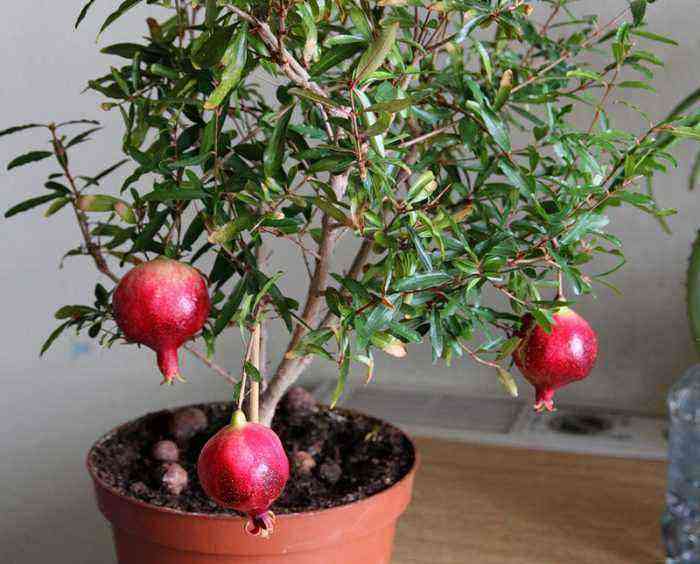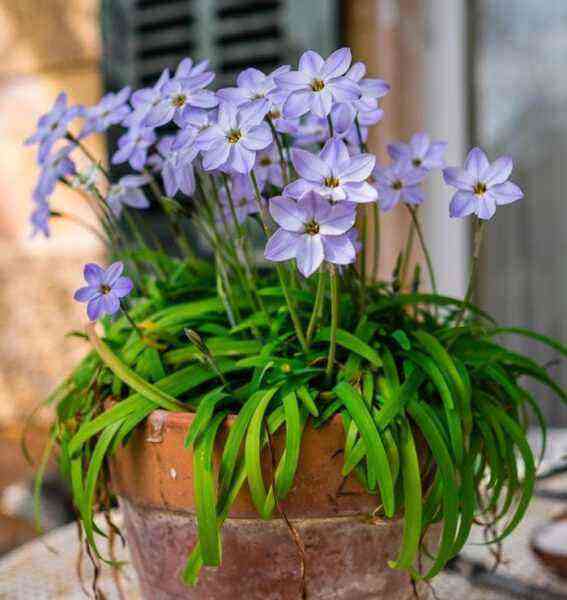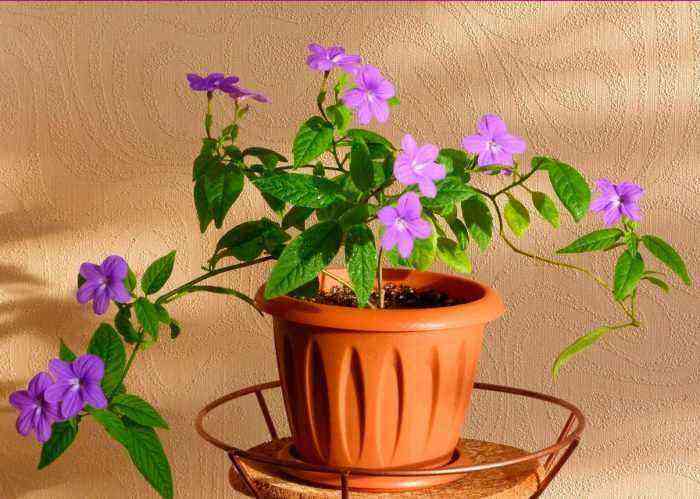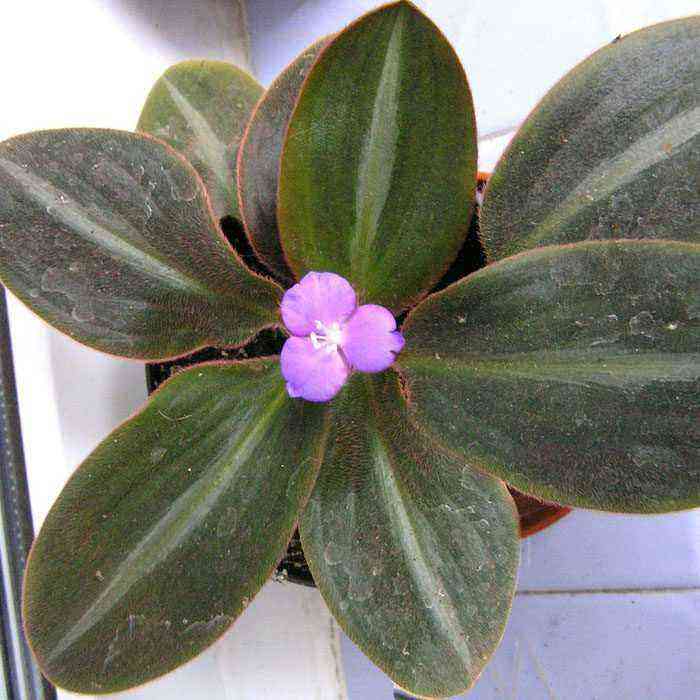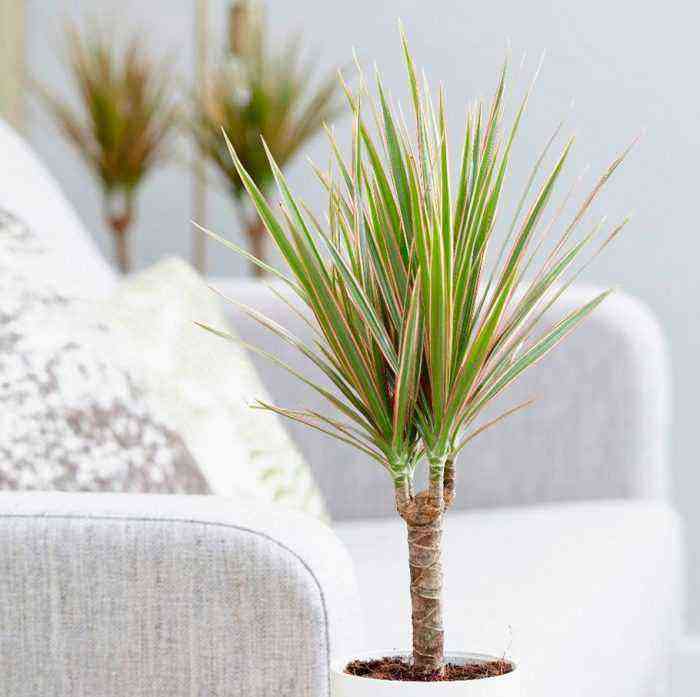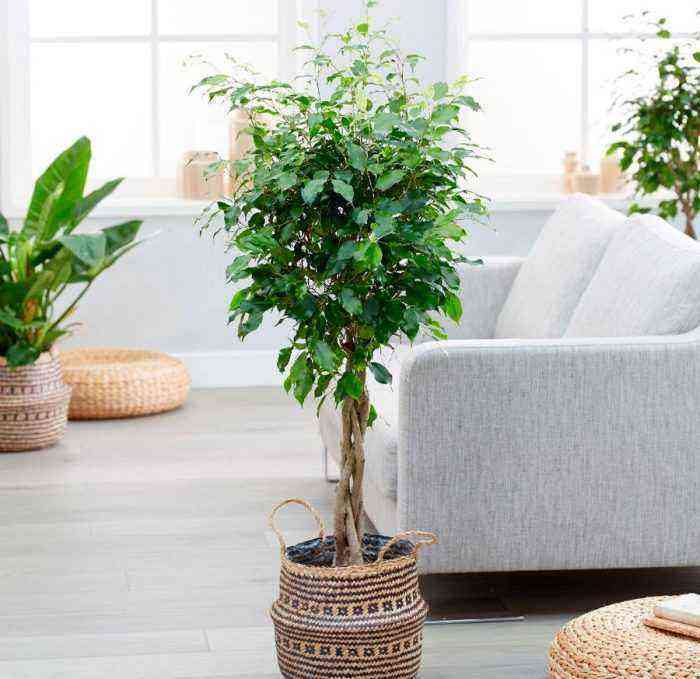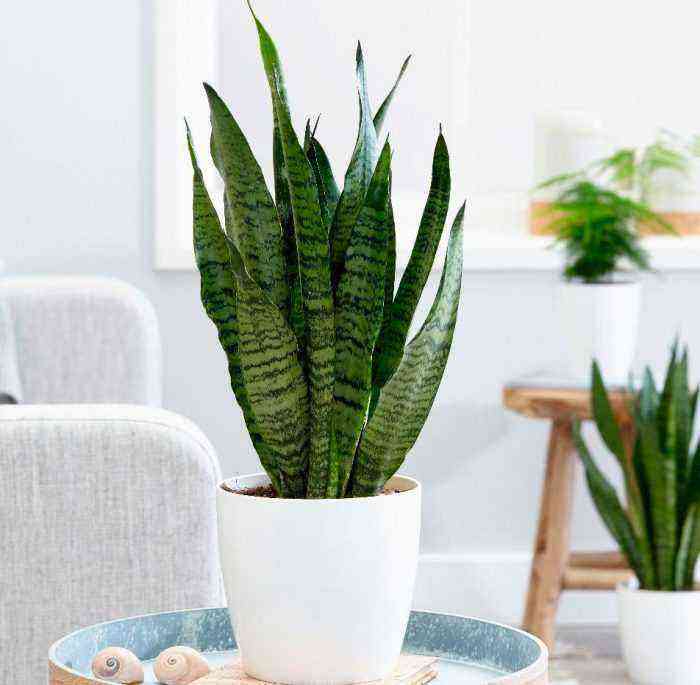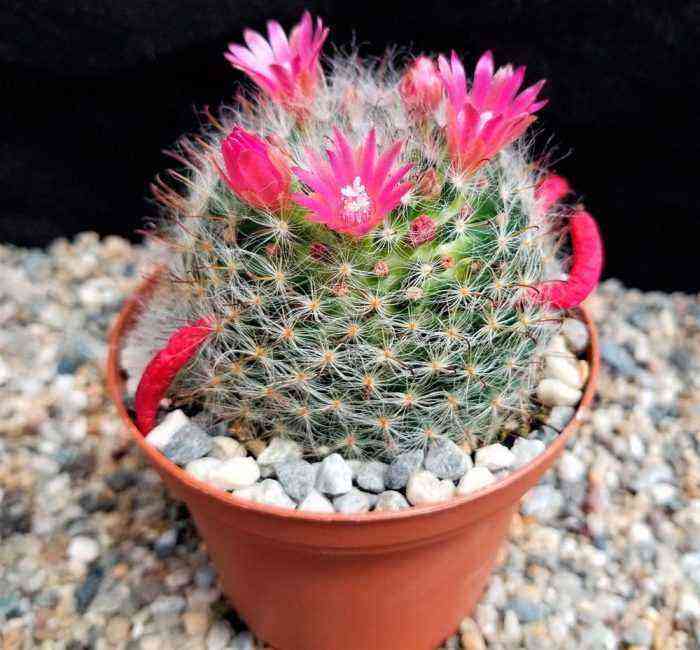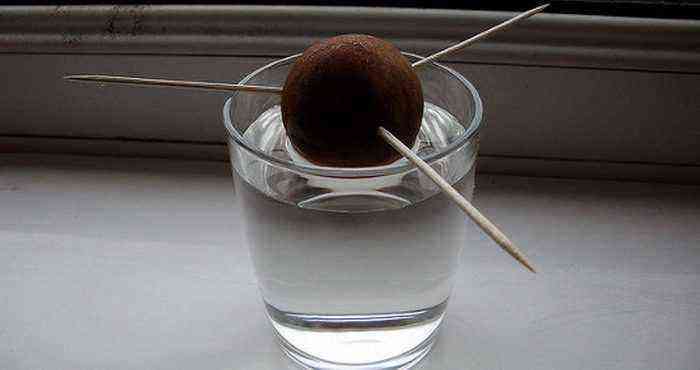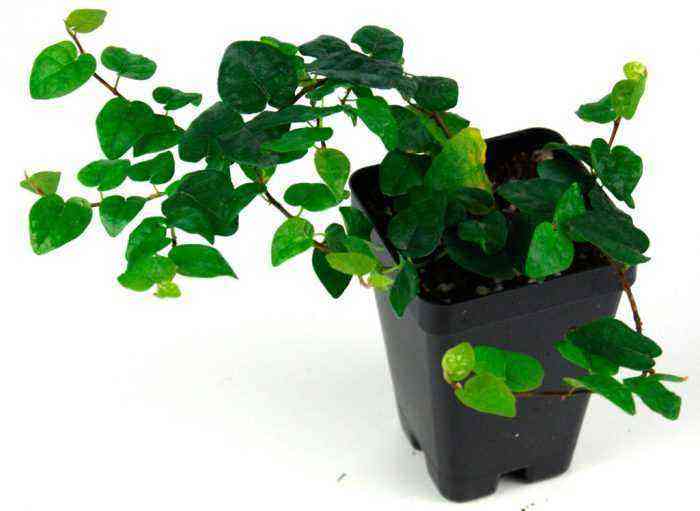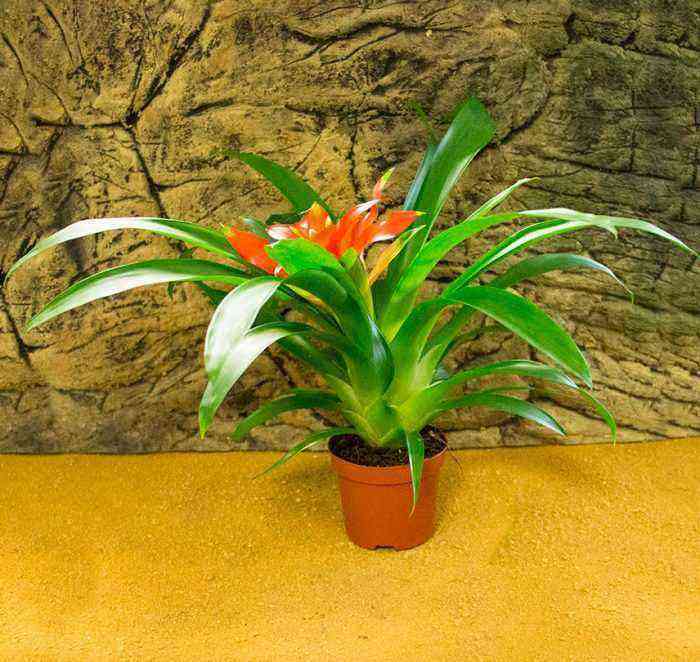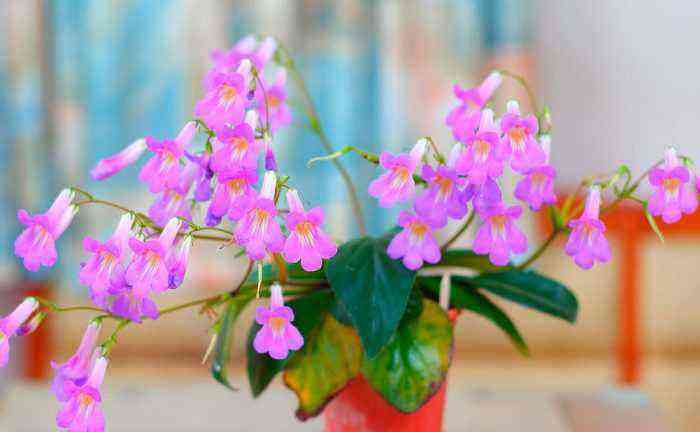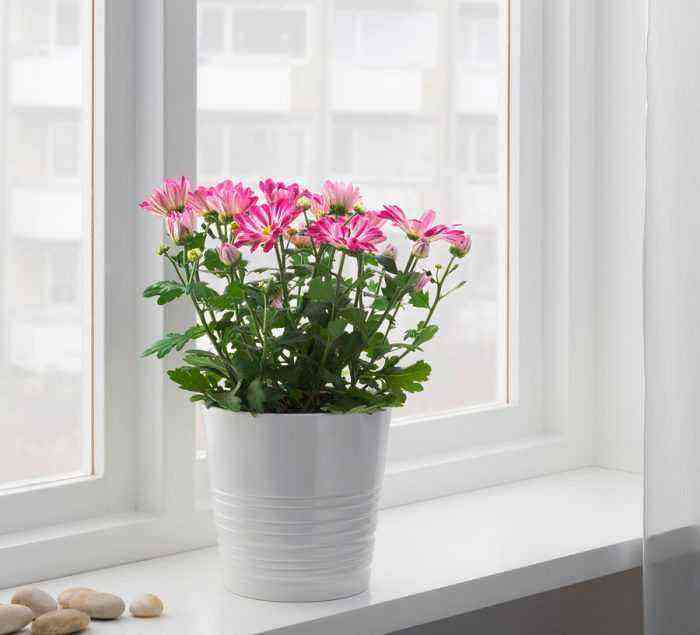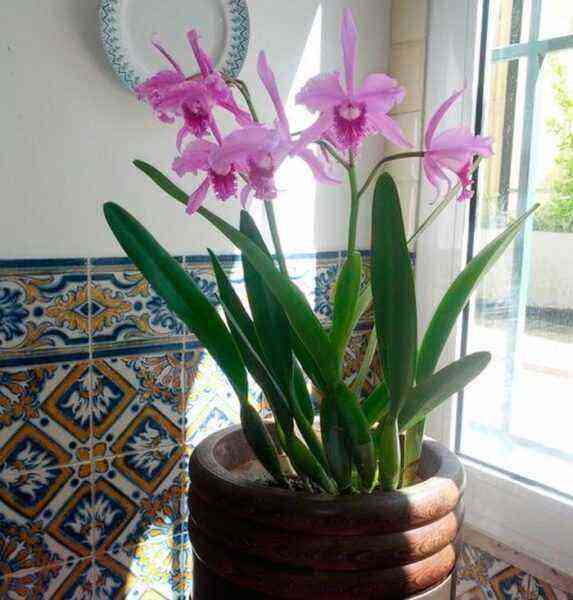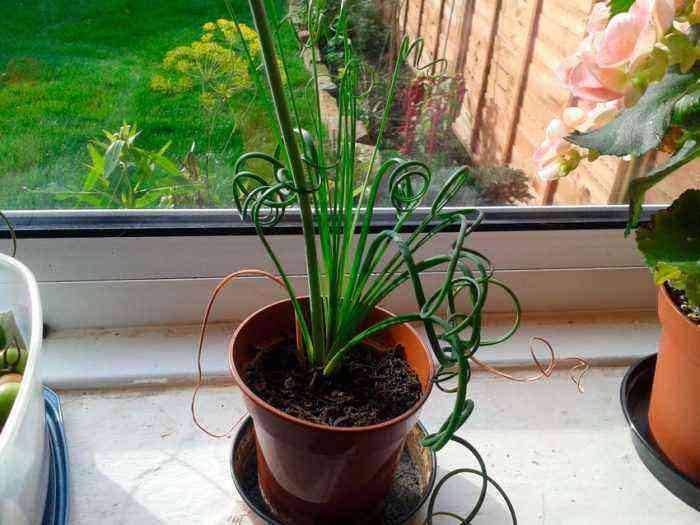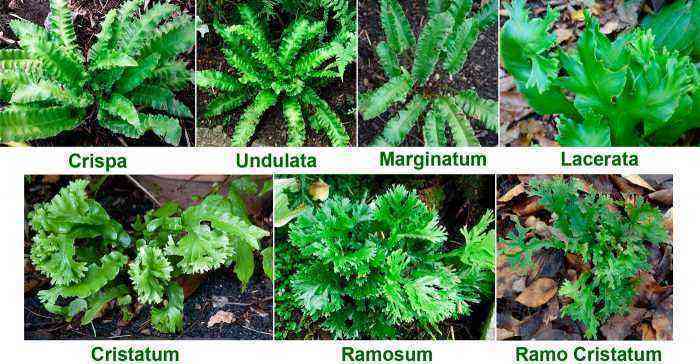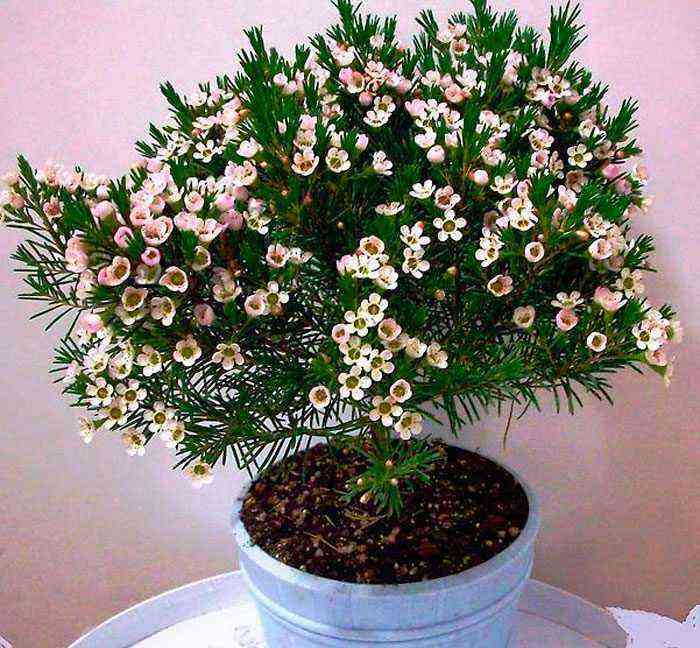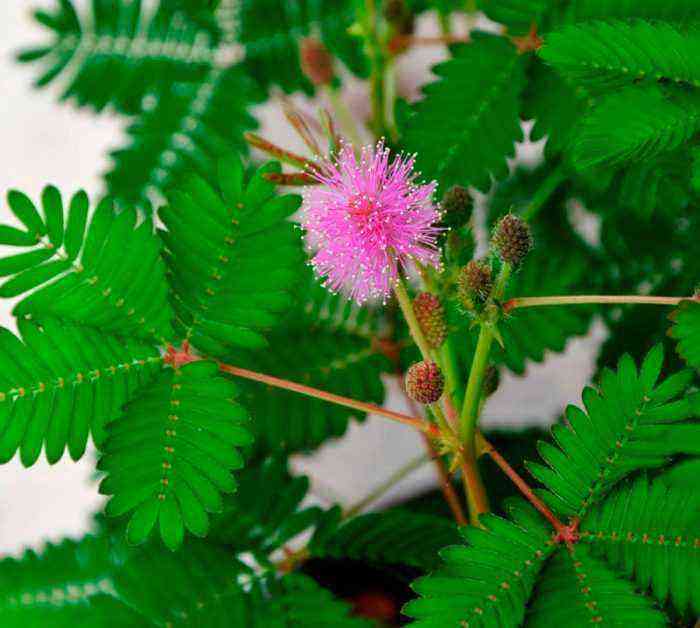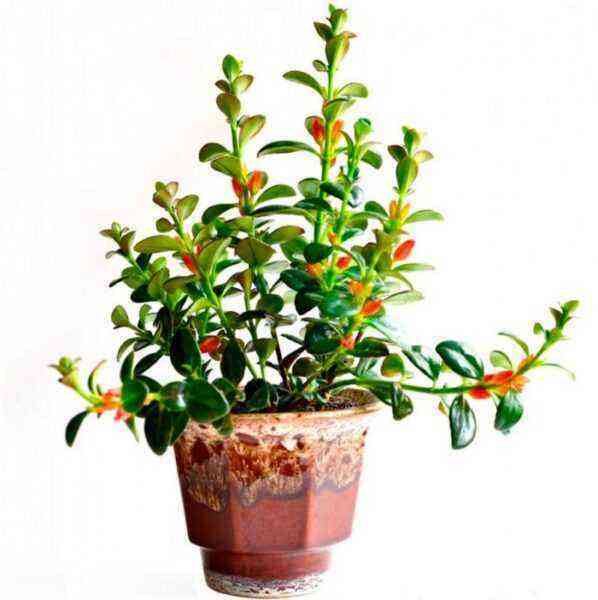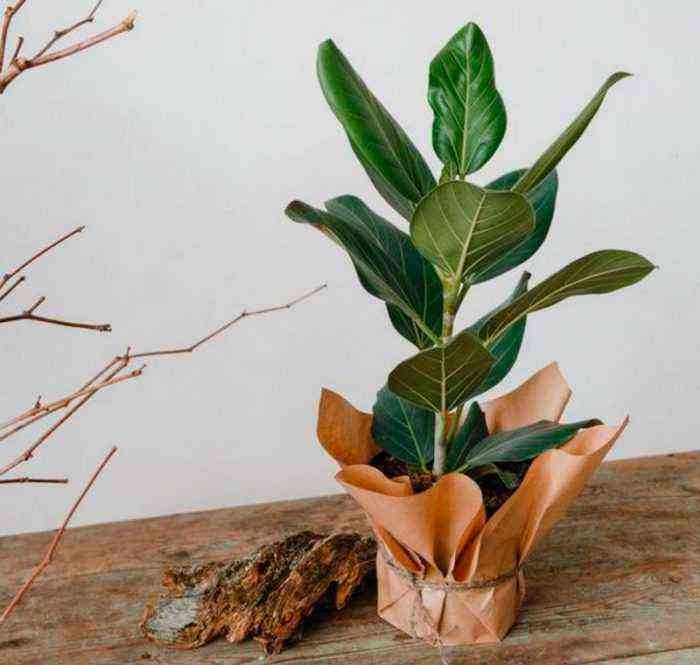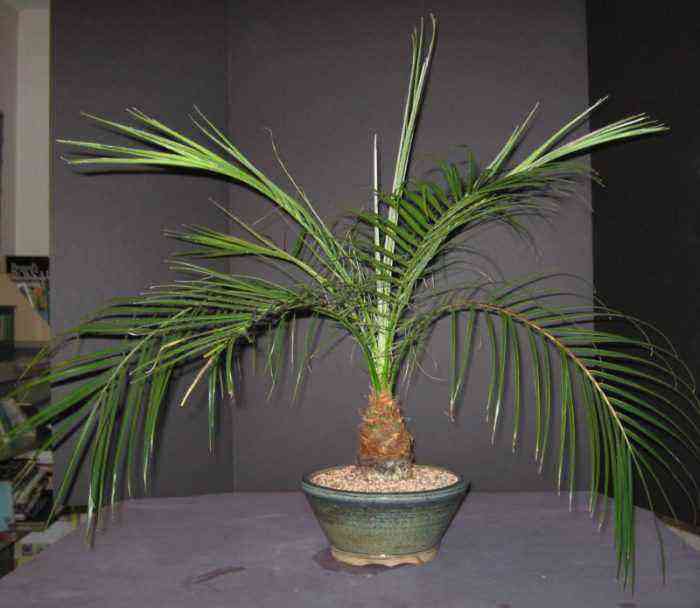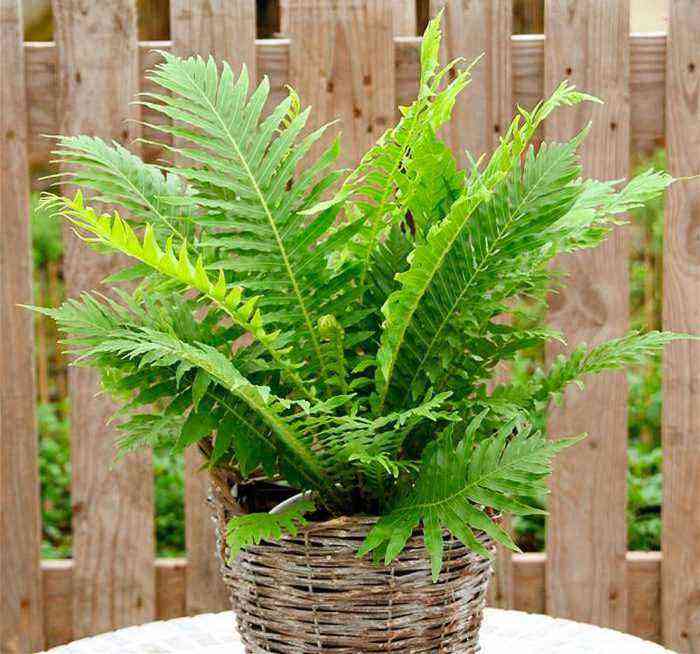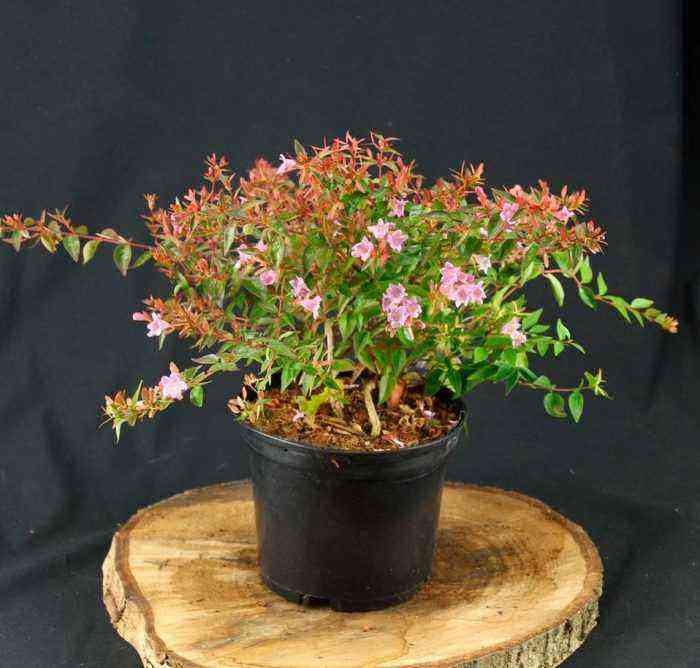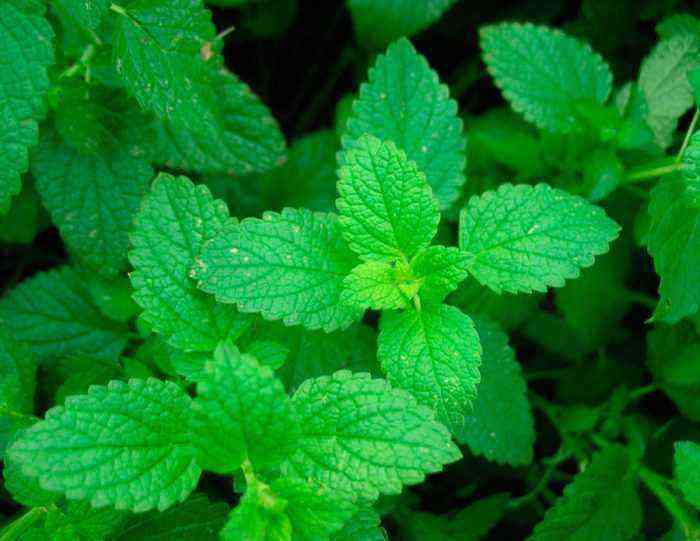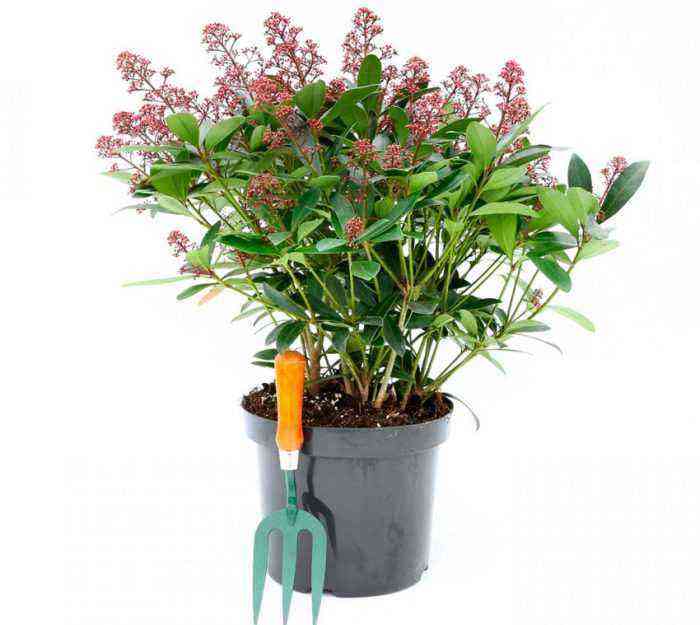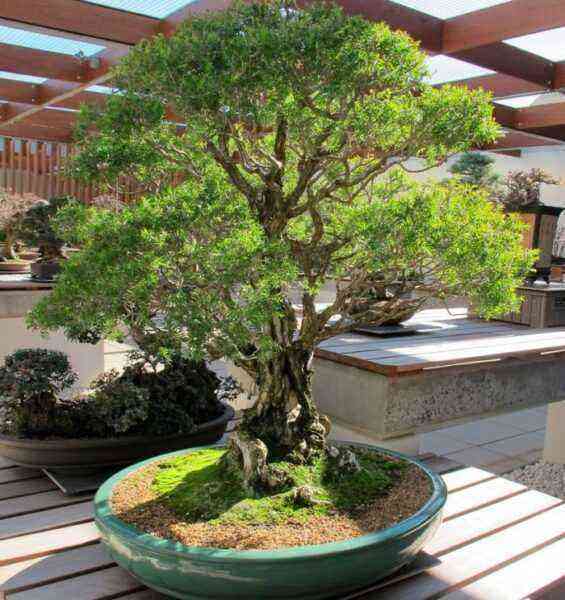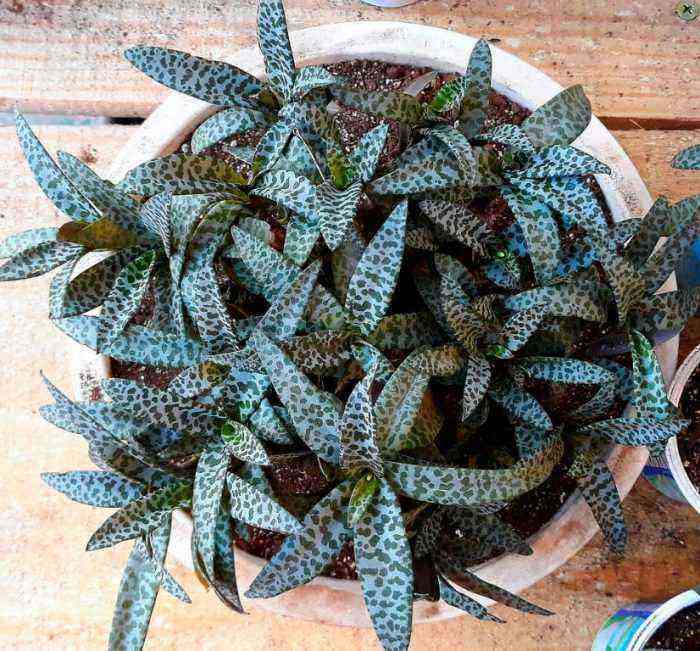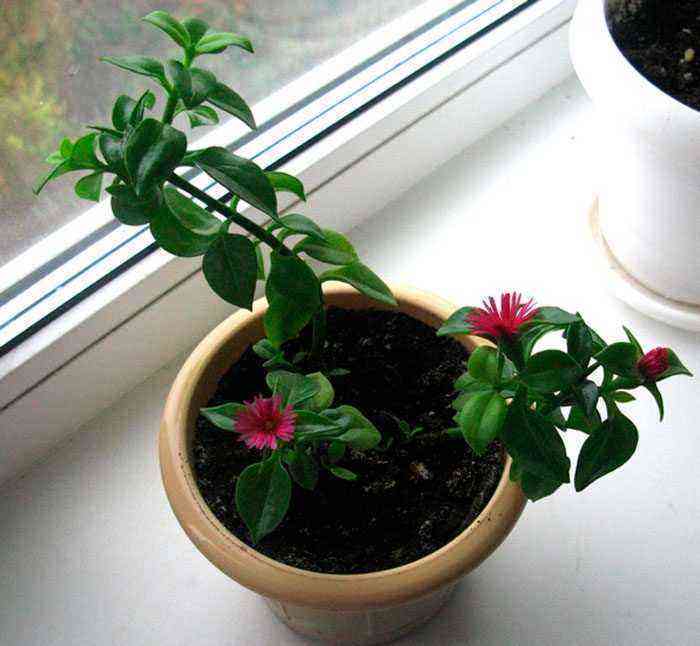For a long time, in many houses you can meet spectacular flowering plants from the subtropics and tropics, for example, orchids, fuchsia and jasmine. Bougainvillea flower growers began to grow quite recently. And in vain they did not pay attention to her for so long, the fact is that in Brazil, where she comes from, and in other countries with a similar subtropical climate, her flowering lasts all year. The tops of its stems are always decorated with flowers with dense, spectacular bracts, which have a rich color. In addition, such a plant is unpretentious, it grows on the sides of roads, among stones, braids many-meter rocks, and also climbs the walls of high-rise buildings. In indoor conditions, only a part of the species and hybrid varieties of culture is successfully cultivated.
Home bougainvillea care
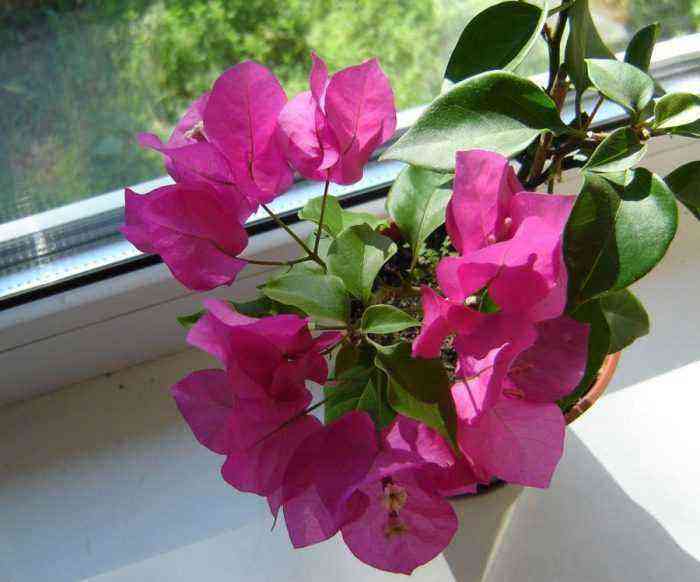

Originally bougainvillea from Brazil. There, its growth and flowering does not stop for a single day, because it does not have a dormant period. Such a heat-loving plant can withstand a drop in air temperature up to 5 degrees, but if it is colder, then it may die. In parts of the subtropical regions of the Caucasus, the culture is grown in open soil all year round. But if there is a threat of lowering the air temperature to critical values, then it must be covered so that it does not suffer from the cold.
In the middle latitudes of Russia, such a plant is cultivated exclusively in greenhouses. Greenhouses, greenhouses and residential buildings are ideal for its cultivation. The main thing to remember is that bougainvillea needs a lot of bright light and space. When grown in indoor conditions, as a rule, the culture did not have enough light or space, and it began to adapt to new growth conditions. As a result, her flowering became not year-round, and she also had a pronounced dormant period. If you take care of the plant correctly and provide it with growth conditions as close as possible to natural, then during the year it can bloom several times.
Illumination
For growing bougainvillea, you should choose the sunniest place. A south-facing window sill is ideal for this; in extreme cases, it can be placed on the west window. Remember that during the day the flower should be illuminated by direct rays of the sun for at least 5 hours. By the way, the scorching rays of the midday sun are not afraid of it. Only if he has enough light, his growth and development will be within the norm, and during the flowering period his perianths will have a bright color. If the lighting is too poor, then because of this, the stems will become elongated, the leaf plates will fade, and the bougainvillea will not bloom.
Temperature


The room where the flower is located must be systematically ventilated, but at the same time, be sure to protect the bush from a draft. Do not expose it to air currents. In the summer, when it is warm outside, if possible, it can be transferred to fresh air (to the veranda, to the garden or to an open balcony). In this case, a place is chosen for him that has reliable protection from precipitation and gusts of wind. In winter, the plant can be transferred to a closed loggia, which must be insulated and well lit. Please note that it should not be colder than 10 degrees on the loggia.
The culture reacts negatively to frequent rearrangements from one place to another, especially during flowering. Because of this, the plant can be severely damaged, especially if, after the rearrangement, the conditions for growth have sharply changed for the worse. Because of this, both flowers and foliage can fly from the bush. In this case, it is recommended to return the bush to its usual environment with a suitable temperature and lighting, after a short time new foliage will begin to grow.
In spring and summer, during the period of intensive plant growth, the temperature in the room should be from 22 to 25 degrees. During the dormant period in winter, it is recommended to transfer the bush to a cooler place (from 12 to 16 degrees). Cool wintering will allow the plant to lay a large number of flower buds, and with the onset of the spring months, the bush will certainly delight you with lush flowering. In the event that bougainvillea is warm in winter, it should be sure to provide additional lighting, while the required duration of daylight hours is about 12 hours. To do this, a fluorescent lamp or phytolamp is installed near the plant. In this case, the dormant period will not begin at the bush, and a small number of flowers will bloom on it. However, with a warm winter and in summer, the bush will bloom very weakly.
Air humidity


The culture needs high humidity. That is why it needs to be regularly and often moistened with a spray bottle. During the flowering period, only the air near the bush is moistened from the sprayer, because it is extremely undesirable for drops of water to hit the surface of the bracts. When the plant does not bloom, it is better to moisturize its foliage on both sides, and this will only benefit it.
There are other ways to increase the humidity. So, not far from the flower, you can put an open vessel filled with water, and you can also pour moistened pebbles into the pallet and put a pot on it. If possible, get an electric humidifier and use it. Moisten the foliage, and also water the bush with exceptionally soft water, which should be well-settled, passed through a filter or boiled.
Watering
Water the plant abundantly during the vigorous growth seen in the spring and summer. The soil mixture should be slightly damp all the time (not soggy). Watering is carried out immediately after the top layer of the substrate is half dry. On average, watering is carried out 1-2 times every 7 days. You need to pour water into the pot until it starts flowing out of the holes at its bottom. However, remember that although the flower loves moisture, under natural conditions it prefers to grow on rocky soil, so do not allow liquid to stagnate in the substrate. In this regard, the water drained into the sump after watering must be poured out.
With the onset of autumn, watering is gradually reduced so that the bush can prepare for the upcoming dormant period. Between November and February, it should be watered very sparsely and rarely. However, make sure that the earthy clod in the pot does not dry out completely. On average, at this time, watering is carried out once every 1–15 days. The warmer it is in the room, the more often watering is carried out. If in winter all the foliage has flown from the bush, watering is suspended until the end of the dormant period.
Fertilizer


Thanks to the correct and timely feeding, bougainvillea will grow beautifully and bloom luxuriantly. Systematic top dressing with liquid fertilizers is carried out from the beginning of spring to the second half of autumn. For this, fertilizers are suitable for flowering plants with a high content of potassium, phosphorus and iron, thanks to them a lot of buds will form on the bush and the flowering will be lush. Do not overfeed the plant with nitrogen, as this will have an extremely negative effect on flowering.
Soil mixture
The flower needs a fertile light soil that allows water and air to pass through well. To do this, you can use a universal soil mixture for flowering indoor plants, the pH of which should be in the range of 5,5-6,0. If desired, the earthen mixture can be made with your own hands. To do this, you need to combine coarse river sand, sod and leafy soil, as well as humus (1: 2: 2: 1). In order for the soil mixture to be sufficiently loose, it is recommended to add a small amount of chalk, vermiculite, wood ash to it, and to prevent fungal diseases, pieces of charcoal must be added to it. Each of the components must be disinfected to remove viruses, parasites and infections that are present in them. To do this, they can be spilled with freshly boiled water or steamed. Allow the substrate to dry after disinfection.
Pot
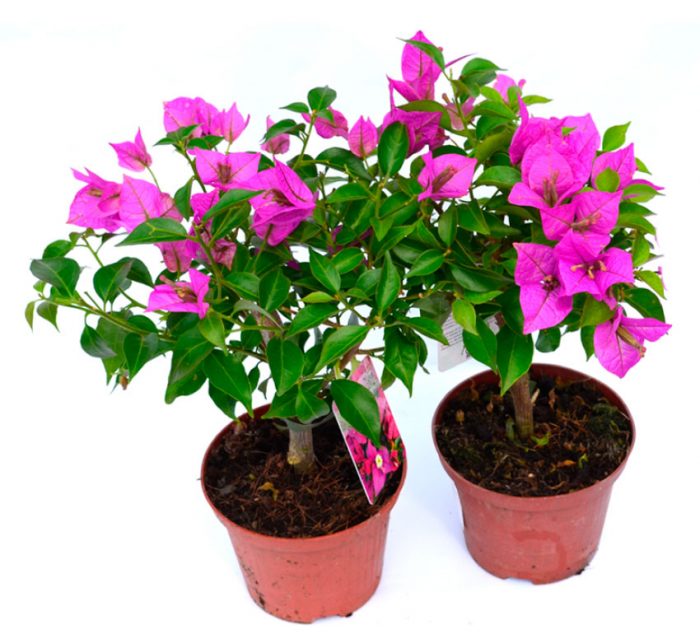

A suitable pot for planting should be only 20 mm larger than the previous container, or a couple of centimeters larger than the root system of the bush, taken together with a lump of earth. If the container is too spacious, then the bougainvillea will grow vigorously greens and the root system, which will have an extremely negative effect on flowering. In addition, thin roots are not able to master the entire volume of soil mixture in a short time, which means that liquid will stagnate in it, which will lead to acidification of the substrate. The capacity should be high, but not too wide.
Before planting at the bottom of the pot, make a drainage layer with a thickness of 30 to 40 mm, for this you can use large pebbles, expanded clay or foam.
Bougainvillea transplant
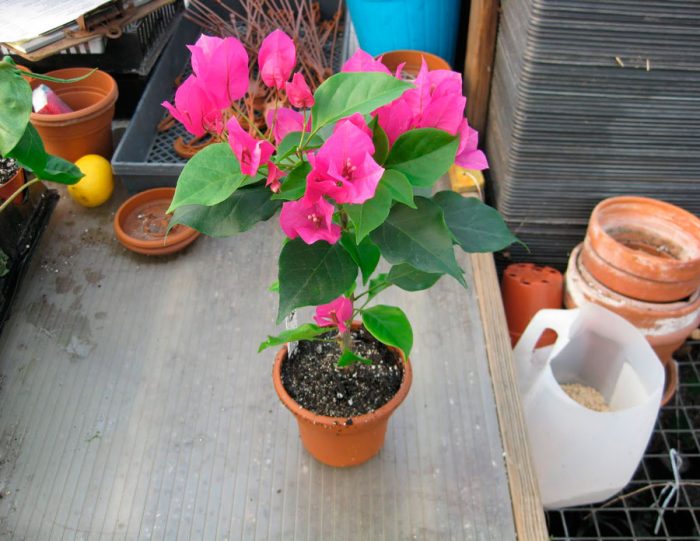

The dormant period ends in early spring and the bush begins to grow actively. At this time, you can observe the beginning of intensive growth of foliage, shoots and roots. It is at the beginning of spring that it is recommended to carry out a flower transplant.
Young specimens grow very quickly. When grown in greenhouse conditions for 12 months, the height of the bush can increase by 300 centimeters. Remember that the larger the container, the longer the stems and branches will grow. If the bush grows in a tight container, then its height will not increase so actively, but it will bloom very luxuriantly. While the plant is young, it is transplanted regularly once a year, this allows you to restore the nutritional value of the soil. Adult plants are transplanted much less often, namely, once every 1 or 1 years, since they tolerate this procedure very poorly. Often, the transplanted bush is very sick for the first time, does not bloom, and its foliage flies around. In this regard, it is recommended to transplant it by transferring it into a larger container, while trying not to injure the root system. After transplanting, check the root collar, it should not be buried. The free space in the container is filled with fresh soil mixture, while it is not necessary to compact it, but make sure that there are no voids left. The transplanted bush is watered and removed to a shaded place for several days, this will allow the root system to quickly take root and get used to the new soil mixture. After that, the flower is transferred to its old place.
In an adult bush, the stems on which the flowers are located weigh a lot, so they need support. To do this, install a support made of wire or bamboo. While the plant is young, a wire staple is enough for it. Bend it in half, fold it at the desired angle and stick it into the substrate at the base of the bush.
Flowering


It is thanks to its spectacular and long-lasting flowering that bougainvillea is so loved by flower growers. Flower buds are laid during the dormant period in winter. And in May, flowering begins, and the bush becomes more like a large colorful bouquet, consisting of opened inflorescences and spectacular bracts, because of them sometimes it is even impossible to make out the leaves. Indoors, with good care, bougainvillea can bloom for 6-7 months (from May to November). In different varieties, the shape and color of the bracts are different. They can be colored pink, purple, white, magenta, or lilac. Of particular decorative value are those varieties in which terry bracts are placed in several rows. Small flowers of a cream color do not last long, after opening they quickly fade and fly around. Bracts, on the other hand, stay on the branches for a long time, sometimes up to six months or even longer.
To achieve the greatest decorativeness, you can plant 2 bushes of different varieties in one container, for example, with lilac and white bracts. As bougainvillea grows, their trunks intertwine with each other. When the bushes bloom, the house is decorated with a lush purple-white bouquet.
Trimming
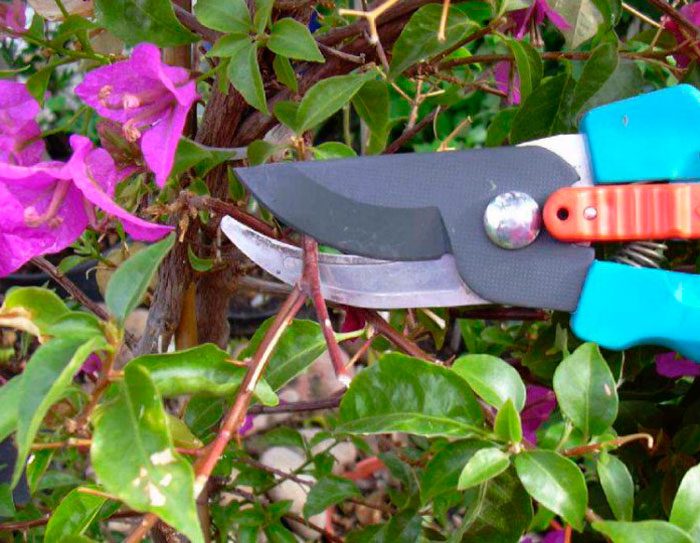

Pruning is considered an important procedure when cultivating bougainvillea indoors. With the help of it, you can not only give the correct shape to the bush, but also stimulate flowering. Several prunings are carried out over the course of one year.
In the spring, injured, weakened and dried branches are removed from the bush. In the summertime, inflorescences are cut from it, which have lost their attractive appearance. In the autumn months, when flowering is over, pruning should also be done. After the bracts begin to fade, young shoots are shortened by 1/3 of their length, while each of them should have from 6 to 8 buds. Those young shoots that grow incorrectly or are superfluous must be cut to the trunk. Old branches that are more than 3 years old should not be touched, because this will not give a tangible effect, but the bush will receive a severe injury.
Also, in the fall, before the dormant period begins, formative pruning is also carried out. If desired, the plant can be given the appearance of a multi-stem bush, and you can also not cut off its shoots, which look like vines, over time, on a support, they are given an unusual shape (for example, a ring or a heart). Also, quite effective compositions are those where branches are twisted around curly frames, decorative trellises or trellises. Remember that in the process of pruning on the stems, you need to leave a sufficient number of buds of the current season, the fact is that dormant buds on old stems wake up very rarely, and therefore young shoots may not appear on the bush at all.
Bonsai
Bougainvillea can be formed in the form of a bonsai – a tree with several branches and one stem. In order to do this, you need to leave 2-3 branches on the bush, and remove all the rest. This look must be maintained for a very long time until the tree becomes lignified. After that, you need to prune all central branches on a stump. Then you need to wait until young shoots grow on the bush. All this time, you need to keep their growth under control: long shoots need pruning and pinching, the extra ones are removed, and those that are directed in the wrong direction are tweaked with wire. After the branches are lignified, the props must be removed. Shortly before the beginning of the dormant period, the formation of the bonsai is suspended, in this case the bush will have time to release young shoots and flower buds will be laid on them. And with the onset of spring, bonsai will be decorated with thick and spectacular inflorescences.
It happens that bare branches appear at the bottom of a mini-tree, which have an extremely negative effect on its appearance. To fix this, cuttings can be grafted onto these branches. First, select a green young shoot from the crown of the plant and cut it off, then tear off all the foliage from it, but this must be done carefully so as not to injure the buds. On the branch, select the location where the inoculation will take place. Make a hole in this place with a drill, while choosing a drill of a suitable size. Then a stalk is installed in it. The cutting will take root quickly enough, and the tree will look more neat. Remember that the stalk must be inserted into the hole so as not to injure the kidneys, especially the one that is located very close to the trunk. Provide good care for the bougainvillea after vaccination. To do this, you need to water it on time, do not transfer it to another place and do not turn it, since there is a high probability that you accidentally disrupt the position of the grafted branches.
Vaccination of a different variety


In order to create a multi-colored spectacular look of bougainvillea, branches of a different variety can be grafted onto the stems of the bush. For example, a cutting from a bush with white bracts is grafted onto a plant with red bracts. Step-by-step vaccination instructions:
- Take a sterilized very sharp instrument and make a shallow side cut in the rootstock.
- Use the same tool to cut the scion from another bush.
- Turn off the end of the scion and place it in the side cut on the rootstock.
- To fix the site of inoculation, a grafting adhesive plaster and medical glue are used. It will be possible to remove the adhesive plaster only after a few months.
Reproduction of bougainvillea
Indoor bougainvillea will be propagated in three ways. Below we will talk about them in more detail.
Cuttings
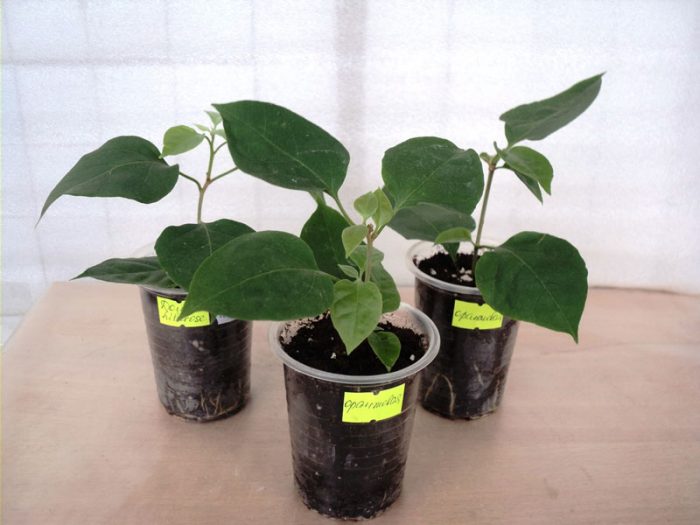

Most often, this exotic flower is propagated by cuttings, since this method is the easiest and most effective. Cuttings are harvested in June, for this they choose semi-lignified shoots. In order not to spoil the appearance of the plant, it is necessary to cut off those branches and shoots that do not bloom, thicken the crown, or grow inward into cuttings. The lower foliage is cut off.
For rooting, cuttings are planted in a substrate of sand and peat, which is poured into a glass, which is then covered with a film, or into a container with a lid. Places of cuts should be treated first with charcoal powder, and then with a means that stimulates the formation of roots, for example: Zircon, Kornevin, etc. Keep the soil mixture constantly moist, and a suitable air temperature should be about 25-26 degrees. Cuttings will need regular airing, and water them when necessary. It is necessary to remove the shelter after the cutting starts to grow. For better rooting, you need backlighting and bottom heating. The stalk will give roots in about 6-8 weeks, after which it is transplanted into a pot, reaching a height of 70-90 mm, which is filled with a soil mixture consisting of leafy soil, compost, peat and sand. The transplant must be carried out with special care, since fragile roots can be easily injured or torn off. You cannot pull a young bush for the trunk. The best option would be to cut the glass in which the stalk was rooted. The transplanted plant is placed in a cool (about 20 degrees) bright place for growing. After the length of the shoots is 50 mm, they are pinched. When the container is filled with roots, the bush is transplanted into a larger pot, reaching 11-12 centimeters across. A good drainage layer must be made at the bottom of the container before planting. A young plant will need abundant watering, but make sure that no liquid stagnation is observed in the substrate.
In some cases, cutting of cuttings is carried out in February or March. They should have 2 or 3 kidneys. All the lower leaf plates are cut off, and those that grow on top are shortened by ½ part, thereby reducing the area of evaporation of moisture, which is very important in the rooting process. The stalk is removed for 24 hours in a glass filled with a solution of a drug that stimulates the formation of roots (Heteroauxin or Kornevin). Further, winter cuttings need to be rooted in the same way as summer ones.
Air Lines
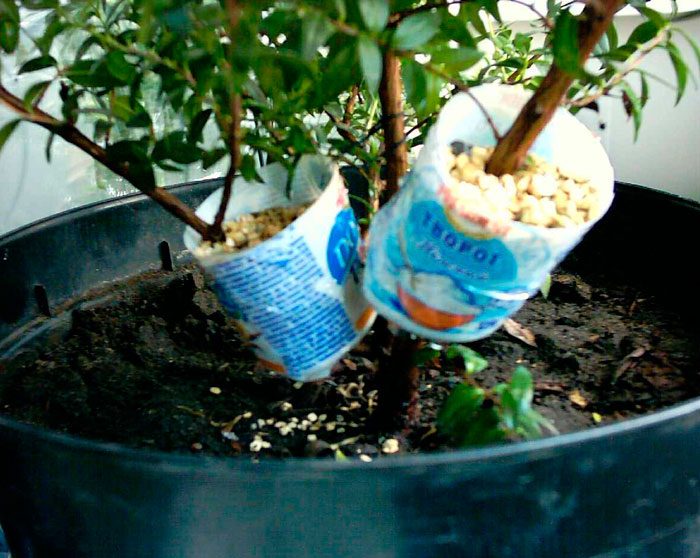

Reproduction by air layers is carried out all year round as needed. Take a small container and fill it with moistened potting soil. Then it is placed near the plant. On the parent bush, a non-lignified young shoot should be chosen, and in the area where it is planned to root, scratches or cuts should be made to stimulate root growth. After that, the prepared shoot must be bent to the surface of the substrate in the container, make sure that the area with scratches fits snugly to the soil mixture. After the cuttings have grown their roots, they are separated from the parent bush and planted in an individual container.
Bougainvillea from seed
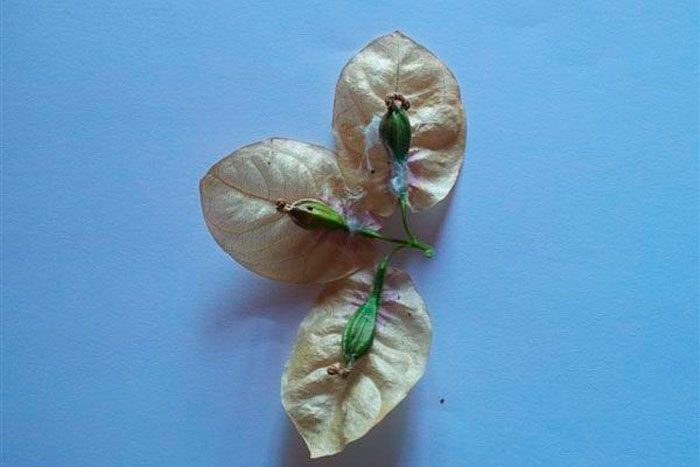

Growing bougainvillea from seeds is not easy. The main difficulty lies in obtaining seeds, since in room conditions those insects that carry out pollination are absent. In nature, flowers are pollinated by small hummingbirds, found only in the subtropics and tropics.
Seed material can also be purchased at a specialized store, but it will take a lot of time and effort to get seedlings from it. Sowing seeds is carried out from the last days of February to the second half of April. To begin with, prepare a fertile loose soil mixture consisting of leafy peat and sand (1: 1: 1), if you wish, you can take a ready-made earthen mixture for flower seedlings. Sowing is carried out in a container with a lid. It is recommended to carry out pre-sowing preparation of seeds, for this they are placed in a solution of any biostimulator for several hours. Sowing is carried out in a moistened soil mixture, while the seeds are buried only 0,5 cm, the distance between the seeds should be within 20-30 mm. When sowing is complete, cover the container with a lid. To make the seedlings appear faster, they need warmth (about 26 degrees). Bottom heating is also recommended, in this case, make sure that the substrate temperature is always 30 degrees. Seedlings will need systematic ventilation and watering as needed, which is carried out with a spray bottle, using well-settled warm water. The seedlings will also need a lot of light. Therefore, in the cold season, a mini-greenhouse will need additional lighting; for this, a phytolamp or a fluorescent lamp is installed. The first seedlings may appear after about 8-12 weeks. As soon as this happens, the cover is removed from the container. If the seedlings are dense, then they should be cut into individual cups, but only after they have formed 2 or 3 true leaf plates. When the bushes grow up and get stronger, they are transplanted into small pots, at the bottom of which a drainage layer is made, the soil mixture is used the same as for planting adult specimens. The flowers are then removed to a permanent place and cared for in the same way as for adult plants.
Why bougainvillea doesn’t bloom
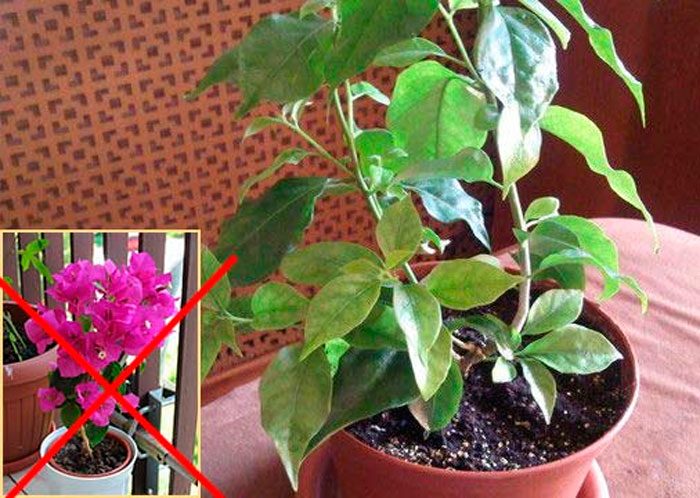

If, when grown in room conditions, bougainvillea does not form inflorescences, then this indicates errors in care or in keeping conditions:
- In the winter, the flower was kept incorrectly, which is why it did not have a full dormant period.
- Throughout the year, the plant did not have enough sunlight.
- An excessively large container was chosen for planting, while the root system of the plant had not yet had time to fill it completely.
- In summer, in damp and cool weather, the bush lacked warmth and light.
- Too much nitrogen was added to the soil mixture.
If you are sure that you did not make such mistakes in care, but the flowers do not appear, then you can try to make the bougainvillea bloom. To do this, suspend feeding, sharply reduce the frequency of spraying and watering. It is necessary to take care of the plant in this way until flower buds form on the young shoots. After that, the bush is systematically fed again (but do not overdo it!) And watered. Remember that if you take proper care of the bush and give it everything you need, then it will certainly delight you with lush flowering.
Bougainvillea disease
A tropical flower like bougainvillea is highly resistant to disease. But if you take care of her incorrectly, then her immunity will weaken.
Leaves fall
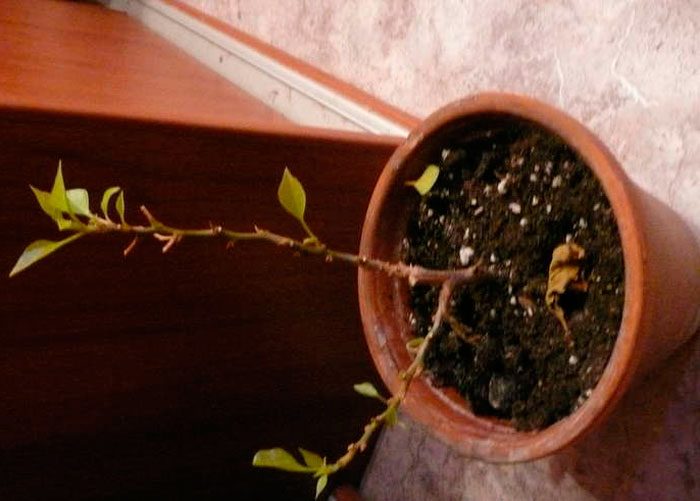

A healthy bush flying around the foliage shortly before the dormant period is a completely natural process. If the leaves fall off at a different time, then there may be several reasons for this: the flower was exposed to a draft, turned the other side to the window, or moved to a new place.
The foliage of a recently purchased plant can also fall off. In this case, dumping greenery is associated with moving, which causes stress in the plant. If the bush begins to bare, then try to provide him with the most comfortable conditions for growth and proper care, in this case, very soon it will overgrow with lush foliage and begin to bloom.
The bush can shed its leaves even when you transfer it to fresh air for the summer and bring it into the house with the onset of autumn. And even if you just move the plant to another place where there will be less light, this can also cause the leaf plates to fly around.
The foliage has faded
If the color of the foliage has become faded, then this may be a sign that the bush is sick with chlorosis. As a rule, the plant is affected by it when the substrate contains too little iron and other nutrients. Feed the flower as soon as possible and spray the foliage with an iron chelate solution.
Spots on the leaves


In the event that soft spots of white color have formed on the surface of the leaf plates, this indicates that stagnation of liquid is constantly observed in the soil mixture, and the room is poorly ventilated. In this case, the room must be regularly ventilated, and also reduce watering to moderate. All the foliage with spots is cut off.
Yellowing and flying around foliage


This may be due to excessive watering, due to which the substrate begins to sour, and the root system does not get enough oxygen. Typically, this problem occurs in winter. In this case, the flower should be watered less often and less water should be used, and also for a while, give up feeding and moisturizing the foliage. It will be very good if he “hibernates” for a while.
The bush became lethargic
If the bush has lost its turgor, it is recommended to treat it with a solution of an agent that stimulates growth. Then it is covered with a bag on top and removed to a shaded place for 2-3 days, and do not forget to systematically ventilate it.
Stopped growing
If you notice that the bush has stopped growing, then this may indicate that it is in an excessively tight container, while the root system has nowhere to grow further. In this case, the flower will need to be transplanted into a larger container.
A very old bush (more than ten years old) may also stop growing. It lignifies and does not form inflorescences. Experts advise, in this case, to multiply bougainvillea in a timely manner.
Root rot
If rot appears on the roots, then you can try to save the bougainvillea. Remove it from the container and carefully remove the soil mixture from the root system. If necessary, first immerse the roots in a container of warm water, and then remove all the soil from them. Then inspect the roots and cut out any that are rotten and injured. The remaining roots must be kept in the Fitosporin solution for some time, and the foliage of the plant is also sprayed with it. After that, all the places of the cuts are sprinkled with wood ash or coal powder. The shrub is then planted in fresh potting soil and well cared for.
vermin


Sucking pests are extremely rare on bougainvillea. You can understand this if a mealy bloom (mealybug) or a cobweb (spider mite) appears on the foliage, and the leaves can also become sticky and faded (aphids). To cleanse the bush of pests, you can resort to folk remedies, namely: give the plant a warm shower, use an infusion of wood ash or garlic, and you can also take a solution of laundry soap for spraying. However, if there are a lot of pests, then it is better to immediately spray the bush with a special insecticide, which can be bought in a specialized store, for example: Aktellik, Aktara or Fitoverm. To accurately get rid of harmful insects, you need at least 2 treatments. Before you start spraying a flower, you must carefully study the instructions attached to the tool.
